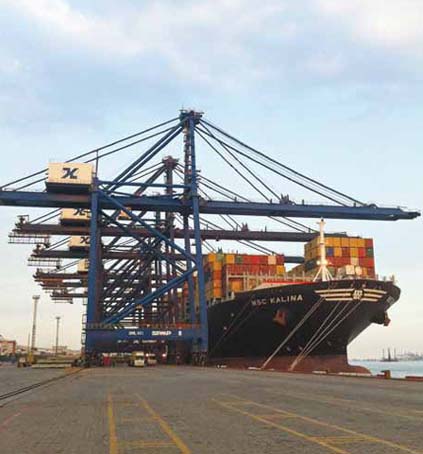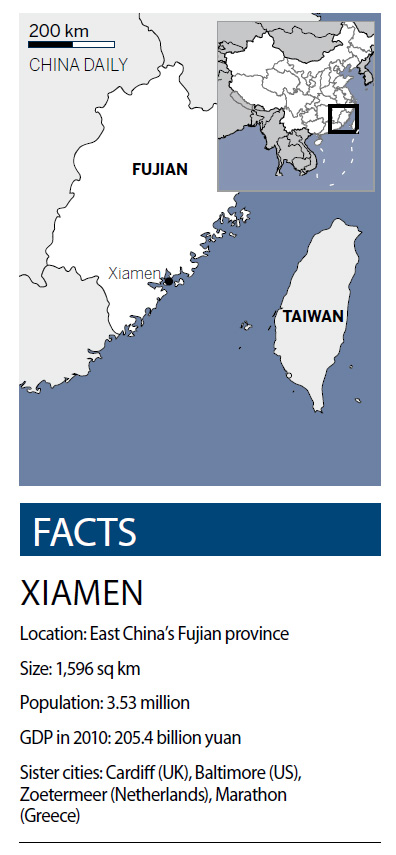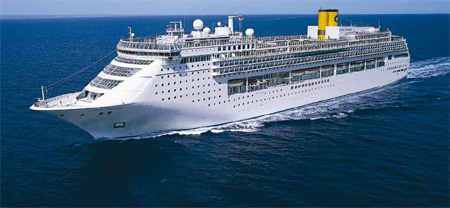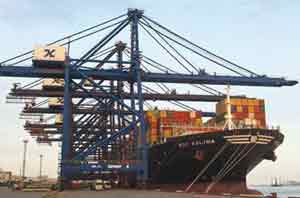Shaping up, shipping out
Updated: 2011-10-21 09:02
By Lu Chang, Chen Xin and Hu Meidong (China Daily)
|
|||||||||
 Xiamen Port had a throughput of 139 million tons of goods and 5.8 million containers last year, ranking seventh in China and 19th in the world. [Photos Provided to China Daily] |
Port helped Xiamen transform into commercial hub
For any recent visitor to Xiamen, it may not have come as a surprise that the city has decades of economic and trade links with Hong Kong, Macao and Southeast Asia. Located in the southeast coast of Fujian province and facing Taiwan across the Straits, Xiamen was chosen as one of the first mainland cities to "open up" to the outside world in 1980.
Since then, foreign trade has been playing a vital role in developing Xiamen. After 30 years, the once sleepy coastal village is unrecognizable. The drab houses, rutted dirt roads and paddy fields have been replaced with a fresh, cutting-edge look - skyscrapers on palm tree-lined boulevards in modern commercial areas. "Xiamen positions itself as an international harbor city. And behind such a proposal is Xiamen's strong growth of foreign trade and its close relationship with Taiwan," says Xiong Yanliang, head of the commerce bureau in the city.
"With the expansion of the Pearl River Delta economic belt and better cross-Straits economic ties, foreign trade will continue to increase."
| ||||
Yu Weiguo, Xiamen's Party secretary, says the ocean and port facilities have been the driving force changing his city.
"In the past three decades, the port sector has played an important role in the growth of the regional economy," he says.
"Port and ocean resources are actually the city's largest advantages, which will serve its future economic outlook."
Xiamen Port, a hub for international trade and bulk cargo, now has 12 port areas.
Major port operators and constructors around the world have invested in Xiamen by building large harbor facilities.
APM Terminals, the port operation unit of the Danish shipping and oil group A.P. Moller-Maersk, owns a 25 percent stake in the Xiamen Songyu Container Terminal at Songyu port area, while the Xiamen Port Holding Group, the major operator of Xiamen Port, holds the rest.
The two invested some $380 million in the first phase of the terminal, which started operations in September 2007.
Last month, Cosco Pacific Ltd, part of the country's largest shipping group COSCO, received 10 cranes from Terex Corp, a US-based heavy equipment maker, to boost its container handling capacity at the Ocean Gate Container Terminal at the Haicang port area.
"As container volumes continue to increase, we need cranes to match growing demand in the long term," says Zhang Junsheng, general manager of Xiamen Ocean Gate Container Terminal.
The terminal was constructed with a total investment of 4.5 billion yuan ($705 million, 510 million euros) and started operating in July. It is a joint venture between Cosco Pacific, holding a 70 percent stake in the terminal, and Xiamen Haicang Investment Company.
According to Zhang, the terminal can handle ships up to 150,000 tons, and with only four berths, its annual capacity can reach 3 million standard containers.
According to 2010 economic statistics released by the Xiamen government, Xiamen Port had a total throughput of 139 million tons and 5.8 million containers last year, ranking seventh in the nation and 19th among the top 100 ports worldwide.
The import and export value exceeded $50 billion last year, 407 times higher than it was 30 years ago, and accounts for more than 25 percent of the local GDP, the city's commerce bureau shows.
The Xiamen Port has 52 berths that can handle vessels of 10,000 tons, among them 10 deep-water berths that can accommodate ships of more than 100,000 tons and is capable of serving the biggest vessels in the world, the Xiamen Port Authority says.
The port has 137 container shipping lines that operate 490 vessels, traveling each month to nearly all of the major ports in the world.
As the first mainland port authorized to handle direct cargo shipping business with Taiwan in 2008, cargo to and from its neighbor now exceeds 3 million containers.
It also has freight routes to Hong Kong, Japan, South Korea, Southeast Asia, Australia, North and South America, Europe and the Middle East.
"We plan to invest 14 billion yuan in the next five years to expand shipping capacity and update the infrastructure to attract more international companies to invest in our ports. And that would also help us to open new routes and acquire more shipment orders," says Cai Liangya, director of the Xiamen Port Authority.
The expansion is necessary to compete with larger ports, such as the Ningbo-Zhoushan facility, the world's top seaport in terms of volume, and ports in Tianjin and Shenzhen.
This is ever more apparent after the volume of exports shrank because of the weakening demand from the US and Europe.
"As an export-oriented port, the production of Xiamen Port was affected by the international financial crisis," Cai says. "Though the industry has picked up, the golden time has passed."
As a result, they are mulling initiatives to boost the port industry.
Since 2010, the Fujian provincial government joined hands with local governments to propose a new program for Xiamen's port business.
The concept is building large-scale industry clusters and port warehouses along with creating a strong logistics network.
Cai says the model calls for support from all industries - transportation, logistics, trading and finance.
"It's expected to extend the industrial chain, and we hope it can be a key breakthrough in Xiamen's economy," he says.
One paramount achievement in the Xiamen port industry in recent years was the integration of the port facilities of Xiamen and Zhangzhou, a coastal city next to Xiamen Haicang district.
This relationship made it possible for both cities to better use resources and favorable policies enjoyed by the former Xiamen Port in terms of taxes, duties, allowances and customs extended to all districts of the former Zhangzhou Port.
"In fact, the port facility construction is certainly important, but the future of the port industry is also about personalized and low-cost services for the customers," says Miao Luping, deputy general manager of the Xiamen Port Holding Group. "A complete set of integrated solutions, from logistics and services network for sea transport to inland transport, is the key to win customers over."
As part of the 12th Five-Year Plan (2011-2015), Xiamen Port aims to have an annual throughput of 200 million tons and 10 million containers by 2015.
Fang Kairui, commerce general manager of Taikoo Aircraft Engineering Company (Taeco) in Xiamen, brims with enthusiasm about the development of the port industry in the city.
Founded in 1993, Taeco was among one of the first foreign companies to base its operations center in Xiamen. Fang says the efficient logistic services in Xiamen Port gives the company easy access to his customers in South and East China.
"We provide 'one stop' services to our customers. So Xiamen's location in the middle of the Yangtze and Pearl river deltas can meet the needs to shorten the delivery time of aircraft components, equipment and materials," he says.
Forty-nine of world's top 500 multinational corporations, such as Kodak, Dell, GM, Boeing, Panasonic, NEC, Toshiba and ABB, have offices in Xiamen, making the city a truly global manufacturing base.














